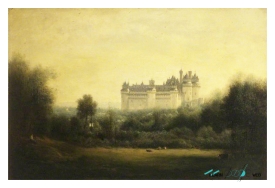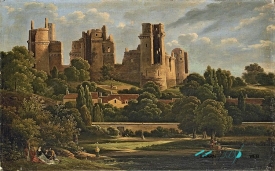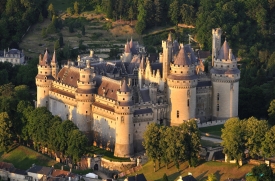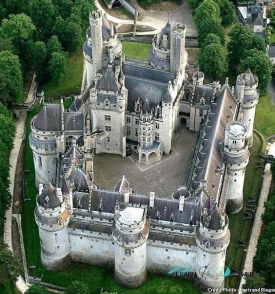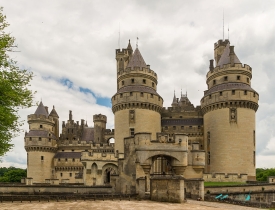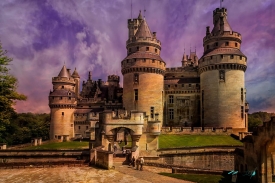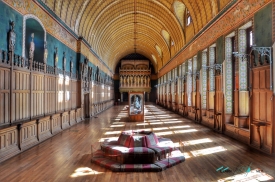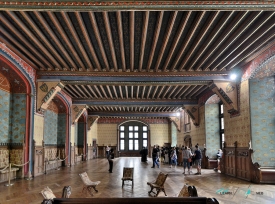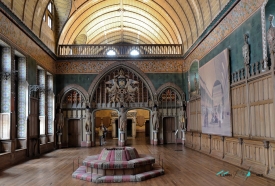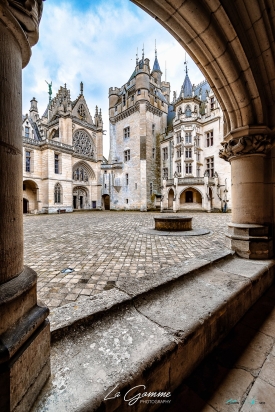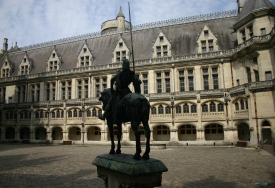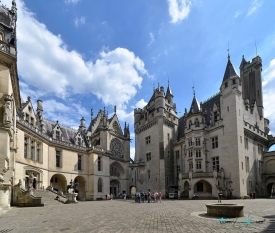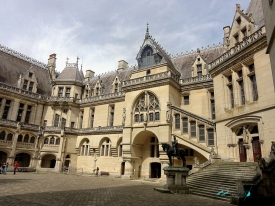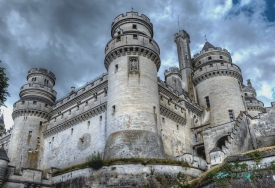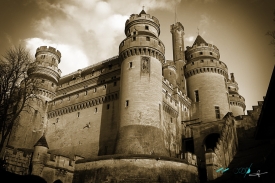The Château de Pierrefonds is an imposing fortified castle built at the end of the 14th century, located in the French town of Pierrefonds, in the Oise department, in the Hauts-de-France region, at the southeastern end of the Compiègne forest , north of Paris.
The castle of Pierrefonds presents most of the characteristics of the defensive work of the Middle Ages. It was rebuilt at this time for Napoleon III by Viollet-le-Duc, who also carried out important works of decoration and furniture.
The castle is classified as a historical monument by the list of 1862. It is managed by the National Monuments Center.
In the 12th century, there was already a castle on the site, built by the powerful lineage of the Nivelons, lords of Pierrefonds, originally from Quierzy. All that remains are the cellars located below the 11th century dwelling. This castle passes at the end of the 12th century to King Philippe Auguste, and then remains in the royal domain.
In 1392, Louis d'Orléans received the County of Valois, several castellanies, including Pierrefonds. In 1396, Louis d'Orléans undertook the almost total reconstruction of the castle. The architect is unknown, although we can probably attribute the building to Raymond du Temple. The site was managed by the Senlis Bailiff's master builder, Jean Lenoir, and supervised after Raymond du Temple's death by the Duchy's master builder Jean Aubelet. In 1406, the king made the county a duchy of nobility, including among others Pierrefonds. The works were interrupted after the assassination of the duke in 1407, when the houses that bordered the courtyard conserved only their two gigantic levels of cellars, but they were never finished.
The castle that controls the passage between the Compiègne forest and the Villers-Cotterêts forest is intended to monitor trade between Flanders and Burgundy, two domains that belong to the family of the Dukes of Burgundy, rivals of Orléans.
In 1411, the supporters of the Duke of Burgundy, led by the Count of Saint-Pol, managed to occupy the castle on behalf of King Charles VI of France. But in 1412 the new Duke of Orleans, after peace with the king, regained possession of the estate from him.
In 1415, after the defeat at the Battle of Agincourt, Charles was taken captive to England; he will remain there for twenty-five years. The captain of Pierrefonds, Nicolas Bosquiaux, resists until 1420, but the harsh winter and the prevailing food shortages force him to capitulate to the partisans of England. This place remains a Burgundian base until around 1436, when it is then commanded by an Armagnac.
Charles d'Orléans did not return to France until 1440 but withdrew his Touraine prerogatives. However, he had the castle repaired. The fortress then fell into the hands of his son, the future King of France Louis XII. Upon his accession to the throne, Louis XII handed over the Duchy of Valois to his cousin Francis, his future successor. From 1515, the Duchy of Valois remained attached to the crown until the reign of Louis XIII.
In 1588 the castle was occupied by Captain Rieux, a supporter of the League who was still fighting against Henry of Navarre, who had become King of France. Captain Rieux repelled two attempts by the royal army in 1591. In 1594 Rieux was captured and hanged.
In 1595, the castle was entrusted to Antoine d'Estrées, governor of Île-de-France and, above all, father of Gabrielle d'Estrées, mistress of Henri IV.
On August 10, 1595 Henri de Saveulx (or Saveux) took the castle on behalf of Philip II of Spain. The castle was then occupied by seven hundred to eight hundred Neapolitans and Walloons sent by the Spanish Netherlands. But, after resisting several royalist attacks, Saveulx was taken prisoner and the Neapolitans sold the castle to Antoine d'Estrées.
The castle was besieged and taken in 1617 by the troops of the Governor of Compiègne, the Count of Auvergne, sent by Richelieu, Secretary of State for War, after bombardments that created a flaw in a weak point of the fortress, near the gate . thus allowing the entry of royalist troops into the castle. In May 1617 the council of King Louis XIII decided to demolish the castle. Its dismantling is carried out by the Count of Angoulême. Large towers are blown up by the mine, houses are destroyed, floors and frames are burned. The exterior works are razed, the roofs are destroyed and the sap is indented in the towers and the north curtain walls.
Sold in 1798 as a site of national interest, reacquired by Napoleon I in 1810, the castle was declared a building of national historic interest in 1848.
Prince-President Louis-Napoléon Bonaparte visited the castle in 1850. Years later, already Napoleon III, Emperor of France, he asked, on the advice of Prosper Mérimée, the architect Eugène Viollet-le-Duc to take charge of the restoration of the building in 1857. Initially the plan was to restore only part of the building, ie the keep and the great towers, and to shore up the ruined walls, to leave a 'picturesque ruin'. But in 1861 this plan was abandoned in favor of the creation of an 'imperial residence', in other words, a pleasure palace reserved for court entertainments and hunting. And so, from restoration, the plan moved on to reconstruction and finally to the recreation of medieval architecture.
The castle of Pierrefonds presents most of the characteristics of the defensive work of the Middle Ages. It was rebuilt at this time for Napoleon III by Viollet-le-Duc, who also carried out important works of decoration and furniture.
The castle is classified as a historical monument by the list of 1862. It is managed by the National Monuments Center.
In the 12th century, there was already a castle on the site, built by the powerful lineage of the Nivelons, lords of Pierrefonds, originally from Quierzy. All that remains are the cellars located below the 11th century dwelling. This castle passes at the end of the 12th century to King Philippe Auguste, and then remains in the royal domain.
In 1392, Louis d'Orléans received the County of Valois, several castellanies, including Pierrefonds. In 1396, Louis d'Orléans undertook the almost total reconstruction of the castle. The architect is unknown, although we can probably attribute the building to Raymond du Temple. The site was managed by the Senlis Bailiff's master builder, Jean Lenoir, and supervised after Raymond du Temple's death by the Duchy's master builder Jean Aubelet. In 1406, the king made the county a duchy of nobility, including among others Pierrefonds. The works were interrupted after the assassination of the duke in 1407, when the houses that bordered the courtyard conserved only their two gigantic levels of cellars, but they were never finished.
The castle that controls the passage between the Compiègne forest and the Villers-Cotterêts forest is intended to monitor trade between Flanders and Burgundy, two domains that belong to the family of the Dukes of Burgundy, rivals of Orléans.
In 1411, the supporters of the Duke of Burgundy, led by the Count of Saint-Pol, managed to occupy the castle on behalf of King Charles VI of France. But in 1412 the new Duke of Orleans, after peace with the king, regained possession of the estate from him.
In 1415, after the defeat at the Battle of Agincourt, Charles was taken captive to England; he will remain there for twenty-five years. The captain of Pierrefonds, Nicolas Bosquiaux, resists until 1420, but the harsh winter and the prevailing food shortages force him to capitulate to the partisans of England. This place remains a Burgundian base until around 1436, when it is then commanded by an Armagnac.
Charles d'Orléans did not return to France until 1440 but withdrew his Touraine prerogatives. However, he had the castle repaired. The fortress then fell into the hands of his son, the future King of France Louis XII. Upon his accession to the throne, Louis XII handed over the Duchy of Valois to his cousin Francis, his future successor. From 1515, the Duchy of Valois remained attached to the crown until the reign of Louis XIII.
In 1588 the castle was occupied by Captain Rieux, a supporter of the League who was still fighting against Henry of Navarre, who had become King of France. Captain Rieux repelled two attempts by the royal army in 1591. In 1594 Rieux was captured and hanged.
In 1595, the castle was entrusted to Antoine d'Estrées, governor of Île-de-France and, above all, father of Gabrielle d'Estrées, mistress of Henri IV.
On August 10, 1595 Henri de Saveulx (or Saveux) took the castle on behalf of Philip II of Spain. The castle was then occupied by seven hundred to eight hundred Neapolitans and Walloons sent by the Spanish Netherlands. But, after resisting several royalist attacks, Saveulx was taken prisoner and the Neapolitans sold the castle to Antoine d'Estrées.
The castle was besieged and taken in 1617 by the troops of the Governor of Compiègne, the Count of Auvergne, sent by Richelieu, Secretary of State for War, after bombardments that created a flaw in a weak point of the fortress, near the gate . thus allowing the entry of royalist troops into the castle. In May 1617 the council of King Louis XIII decided to demolish the castle. Its dismantling is carried out by the Count of Angoulême. Large towers are blown up by the mine, houses are destroyed, floors and frames are burned. The exterior works are razed, the roofs are destroyed and the sap is indented in the towers and the north curtain walls.
Sold in 1798 as a site of national interest, reacquired by Napoleon I in 1810, the castle was declared a building of national historic interest in 1848.
Prince-President Louis-Napoléon Bonaparte visited the castle in 1850. Years later, already Napoleon III, Emperor of France, he asked, on the advice of Prosper Mérimée, the architect Eugène Viollet-le-Duc to take charge of the restoration of the building in 1857. Initially the plan was to restore only part of the building, ie the keep and the great towers, and to shore up the ruined walls, to leave a 'picturesque ruin'. But in 1861 this plan was abandoned in favor of the creation of an 'imperial residence', in other words, a pleasure palace reserved for court entertainments and hunting. And so, from restoration, the plan moved on to reconstruction and finally to the recreation of medieval architecture.



